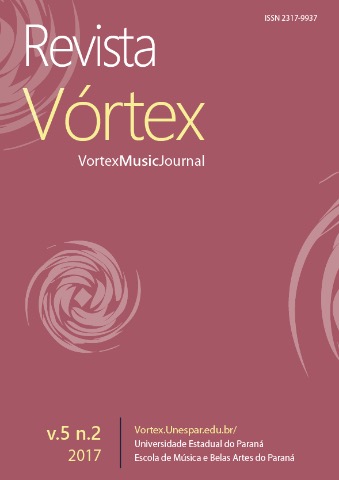A study about the use of Musicomovigrams in musical education
DOI:
https://doi.org/10.33871/23179937.2017.5.2.2149Resumen
Since the turn of the twenty-first century, information and communication technology (ICT) have definitely changed the way people express learning and interact with each other in the activities of science and arts, with a particular impact in musical education. In this article, the authors treat the concept of musicomovigrams, an interactive audiovisual resource, similar to video games that can work as software tools for the development of sound perception and musical structure. This concept is based on the previous concept of musicogram, created by the musical pedagogue Jos Wuytack along with his concept of Active Listening (Wuytack and Boal Palheiros, 2009). The authors consider an important element of learning the concepts of Musical Forms defined by the musical educator Keith Swanwick (Swanwick, 2003). This work presents the development of the musicomovigram concept, a videogame created through the free software eAdventure. We also intend to investigate how music teachers and students, who work and interact in musical education classrooms, are actually accepting and using ICT in their classes.
Descargas
Citas
AZORIN, J. M. El videojuego musical ¿Un recurso para la Educación musical en la educación
primaria?. Ensayos, Revista de la facultad de educación de Albacete, v.29 (2), p. 9-36, 2014.
BOTELLA, A.M.; MARíN, P. El paradigma culturalista en la educación musical. Propuestas didácticas a través del musicomovigram. In J.C. Montoya (Ed,) Nuevas perspectivas pedagógicas para la educación musical. Salamanca: Amarú Ediciones, 2015.
CLARKE, E.F; KRUMHANSL, C. Perceiving musical time. Music Perception, v.7, p. 213-251, 1990.
DELADANDE, F. La música es un juego de niños. Buenos Aires: Ricordi, 1998.
E-ADVENTURE, 2012. Disponível em: http://e-adventure.e-ucm.es. Acesso em: 23 julho. 2016.
ERGAM, H ; SAMS, A. Dale la vuelta a tu clase. Madrid: Ediciones SM, 2014.
GIBSON, J; ALDRICH, C; PRENSKY, M. Games and simulation in online learning: research and development frameworks. Hershey, 2007.
GIRALDEZ, A. Enseñar y aprender en el aula de música. In A. Giraldez (Ed,) Didáctica
de la música en primaria. Madrid: Síntesis, 2014.
GOLDMAN, Richard Franko. Varèse: Ionisation; Density 21.5; Intégrales; Octandre; Hyperprism; Poème Electronique. Instrumentalists, cond. Robert Craft. Columbia MS 6146 (stereo) (in Reviews of Records). Musical Quarterly, v 47, p. 133–34,1961.
HARGREAVES, D. Música y desarrollo psicológico. Barcelona: Grao, 2002.
HURON, D. Listening styles and listening strategies. In E. West. Society for music theory
Conference, Columbus (Ohio), 2002.
JOST, B et al. Graphical programming environments for educational robots: Open roberta - yet another one? in Multimedia (ISM), 2014 IEEE International Symposium on, Dec 2014, p. 381 – 386.
JOBIM E SOUZA, S. Infância e linguagem: Bakhtin, Vygostky e Benjamin. Campinas: Papirus, 1994.
KODU, 2014. Disponível em: http://www.kodugamelab.com/. Acesso em: 23 julho. 2016.
KRUGER, E. S. Educação musical apoiada pelas novas tecnologias de informação e comunicação (TIC): pesquisas, práticas e formação de docentes. Revista da ABEM, v. 14. 2006.
LIZASSO, B. Modelos didácticos de audición musical comprensiva. Música y Educación, v. 94, p. 18-32, 2013.
MADSEN, C.K. Focus of attention and aesthetic response. Journal of Reseach in Music Education, v. 45 (1), p. 80-89, 1997.
MENDOZA PONCE, J. El musicograma y la percepción de la música. Universidad de Huelva, 2014. Disponível em: https://goo.gl/uYGO7h. Acesso em: 23 Junho. 2016.
OLARTE MARTINEZ, M. (Ed.). Reflexiones en torno a la música y la imagen desde la musicología española. Salamanca: Plaza Universitaria Ediciones, 2009.
PATEL, A. Music, biological evolution, and the brain M. Bailar (Ed.). Emerging Disciplines. Houston, TX: Rice University Press, 2010.
PIAGET, J. El nacimiento de la inteligencia en el niño. Barcelona: Critica, 1985.
PINDADO, J. Las posibilidades educativas de los videojuegos. Una revisión de los estudios más significativas. Pixel-Bit: Revista de medios y educación, v.26, p. 56-67, 2005.
PRENSKY, M. Don"™t bother me mom. I"™m learning. Londres: British film institute, 2006.
SCHAEFFER, P. Tratado de los objetos musicales. Madrid: Alianza Editorial, 1988.
SCRATCH, 2014. Disponível: http://scratch.mit.edu/. Acesso em: 23 Junho. 2016
SIEGLES, R.S.; SHIPLEY C. Variation, selection, and cognitive change. In T. Simon & G. Halford (Eds.), Developing cognitive competence: New approaches to process modeling p. 31–76. Hillsdale, NJ: Erlbaum, 1995.
SWANWICK, K. A basis for music education. London: Routledge, 1979.
SWANWICK, K. Ensinando música musicalmente. Trad. Alda Oliveira e Cristina Tourinho. São Paulo: Moderna, 2003.
TILMAN, B.; BIGAND, E. The relative importance of local and global structures in music perception. The Journal of Aesthetics and Art Crticism, v. 62, p 211-222, 2004.
VYGOTSKY, L. Pensamiento y lenguaje. Madrid: Paidós: Madrid, 1995.
WILLEMS, E. El oído musical. Barcelona: Ediciones Paidós Ibérica, 2001.
WUYTACK, J.; BOAL-PALHEIROS, G. Audición musical activa. Porto: Associação Wuytack de Pedagogia Musical, 1996.
WUYTACK, J.; BOAL-PALHEIROS, G Audición activa con el musicograma. Eufonia, v. 47, p 43-55, 2009.
Descargas
Publicado
Cómo citar
Número
Sección
Licencia
Derechos de autor 2017 Vortex Music Journal

Esta obra está bajo una licencia internacional Creative Commons Atribución 4.0.
Los autores conservan los derechos de autor y conceden a la revista el derecho de primera publicación, con el trabajo simultáneamente bajo la licencia Creative Commons Attribution Licence que permite compartir el trabajo con reconocimiento de autoría y publicación inicial en esta revista.






